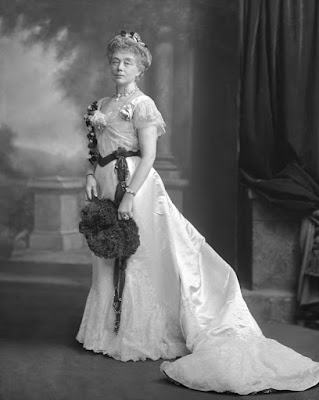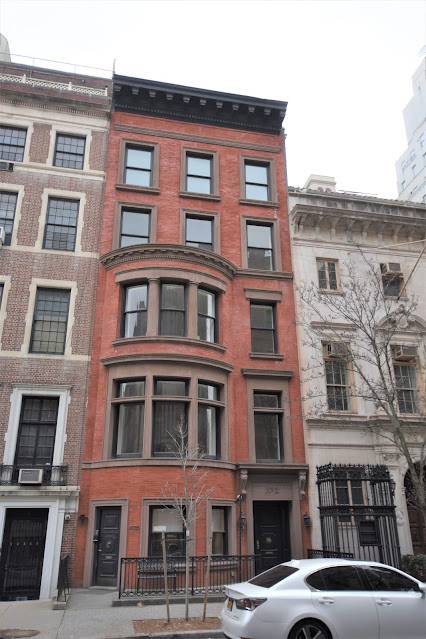On September 5, 1865 Emma Congdon married William Henry S. Wood. Twelve years late they began construction on a new home at No. 8 East 63rd Street. The couple's choice of architects is not surprising. While Henry Congdon is best known for designing religious and civic buildings, he was a relative of Emma.
Their 25-foot wide house was four stories tall above a high English basement. The block was filling with handsome homes like theirs as fashion moved up Fifth Avenue from below 55th Street. The couple moved in in 1878 with their four sons, William Congdon, Gilbert Congdon, Arnold, and Philip Hopkins.
Their 25-foot wide house was four stories tall above a high English basement. The block was filling with handsome homes like theirs as fashion moved up Fifth Avenue from below 55th Street. The couple moved in in 1878 with their four sons, William Congdon, Gilbert Congdon, Arnold, and Philip Hopkins.
Wood had entered his father's publishing firm, William Wood & Company, in 1859 and was made a partner in 1865, the year he married. Following his father's retirement in 1870, he took over as head of the firm. According to the 1915 Genealogies of the State of New York, "he steadily built up the medical publishing business until the firm became the first in its line in this country." Emma, too, had family ties to the medical community. Her uncle was John Hopkins, of Baltimore.
The family increased with the birth of a daughter, Mary Underwood, on July 19, 1881. Sadly, Philip died the following year at the age of seven.
The Woods were Quakers, The Publisher's Weekly later saying that Henry was "a member of the Orthodox Society of Friends and a liberal benefactor of that organization." He was well-rounded, with a deep interest in science and the arts. He sat on the staff of the Department of Entomology at the Brooklyn Institute of Arts and Sciences, was a member of the Scientific Alliance of New York, the Grolier Club, the New-York Historical Society, the New York Botanical Society, among others.
The couple gave a notable entertainment on November 25, 1887. The New York Times entitled an article "English Quakers Entertained" and reported that the Woods "gave a reception last night at their residence...for Joseph Storrs Fry and Joseph Bevan Braithwaite, of London, which was attended by about 100 of the leading Friends of the city." The article noted that Fry was "one of the greatest manufacturers of chocolate and cocoa in England." He had been offered knighthood by Prime Minister William Gladstone, "but as a consistent Friend he refused the title." Braithwaith was a vice president of the British and Foreign Bible Society and a Queen's Counselor.
Emma Congdon Wood died of a heart attack on November 26, 1896 at the age of 52. Her funeral took place in the house two days later.
Henry sold No. 8 in March 1898 to Joseph Hodges Choate for $85,000--about $2.7 million today. Three months later Choate purchased No. 10, giving him a 50-foot wide plot on which to erect a sumptuous new home. Apparently confident that he would acquire the properties, he had hired mansion architect C. P. H. Gilbert before the transactions were complete. On February 8 that year--a month before Choate took title to the Wood house--The New York Times reported that Gilbert was working on plans for the new house. The article said it "will be five stories in height, will be most complete in its appointments, with mosaic and marble floors, electric lights, and an electric elevator."
But the those plans would never come to pass. President William McKinley appointed Choate Ambassador to the United Kingdom and the Choate family moved to London. C. P. H. Gilbert now changed course, filing plans to remodel No. 8 at a cost of just under $670,000 in today's money. He removed the stoop, lowered the entrance to sidewalk level, and added a bowed three-story bay. Despite the extensive renovations, it retained much of the appearance of a house of a generation earlier. While the Choates were in England, Henry Wood stayed on at No. 8, a convenient arrangement for all parties.
This photograph of Choate was taken on January 1, 1898, the year he purchased the 63rd Street house. from the collection of the Library of Congress
The Choate family moved in when Joseph's ambassadorship ended in May 1905. But seven years had passed and, apparently, another updating was deemed necessary. C. P. H. Gilbert was brought back to do interior renovations that September.
Joseph Choate's wife was the former Caroline Dutcher Sterling. The couple had married on October 16, 1861. They had five children, two of whom were deceased. Ruluff Sterling Choate died on April 5, 1884 at the age of 19, and Josephine died on July 20, 1896, at 27-years-old. The others were George, Mabel, and Joseph, Jr.
Born in 1832, Choate had begun his legal practice in 1855. In 1860 he became a partner in Evarts, Southmayd & Choate, one of the leading law firms of the country.
Caroline Choate as she appeared at the Coronation of King Edward VII and Queen Alexandra. from the collection of the Victoria & Albert Museum
The Choates had been popular among London society and they now played host to titled British in their New York townhouse. On April 3, 1906, for instance, The New York Press reported that they "gave a dinner in their home, No. 8 East Sixty-third street, last night, for Earl and Lady Grey and the members of their party." And on January 28, 1912 The New York Times reported that Princess Patricia, granddaughter of Queen Victoria, had been guest of the Choates for tea the previous afternoon.
In the meantime, Joseph Choate continued his diplomatic and legal work. In 1907 he was one of the representatives of the United States at the second Peace Congress at the Hague.
The family summered at their estate, Naumkeag, in Stockbridge, Massachusetts, designed by McKim, Mead & White in 1885. It was there in August 1911 that Joseph and Caroline celebrated their golden wedding anniversary. Joseph's devotion to his wife was reflected in his answer to the question, "If you had been born someone else, who would you like that to be?" He replied, "Mrs. Choate's second husband."
When newspapers reported on Choate's 82nd birthday in January 1914, there were hints of his failing health. The Knickerbocker Press noted "He celebrated his birthday quietly at his home," adding, "Mr. Choate has been in bed for a week with a severe cold."
Three years later the news was similar. The Troy Times reported on January 25, 1917, "Although he was so ill with influenza that he was confined to his bed...Joseph H. Choate hoped to be able to receive callers on his eighty-fifth birthday." He died less than four months later, on May 15. In reporting on his death, the American Scenic and Historic Preservation Society noted, "It is safe to say that there was not a man living who had taken such a prominent and active part in public affairs, who was so universally respected and for whom his fellow-citizens had such a deep and real affection."
Joseph H. Choate left an estate appraised at $4,857,762--or about $82.5 million in today's money. Caroline received an annuity of $75,000 as well as $250,000 outright, and the life use of the two houses. He was generous to the domestic staff, leaving $2,000 each to Ellen Paterson and John E. Osborn for their "long and faithful service," and $250 (about $4,250 today) to the six other household servants.
Joseph H. Choate, Jr. had married Cora Lyman Oliver in 1903 and the couple lived in the 63rd Street house with Caroline and Mabel, who had never married. Mable devoted her time to philanthropic work. While the war raged in Europe, she focused much of her attention to the American Red Cross. After peace came she was involved with a number of causes, including Fordham Hospital and the British Educational Mission to America. Her mother devoted much of her time to the development of Barnard College and served on its Board of Trustees.
The amicable relations within the Choate house became strained in 1920. On March 30 The New York Times entitled an article, "Politics Divides Choates" and explained that Caroline was supporting General Leonard Wood as the Republican nominee for President, while Mabel (a delegate to the Republican National Convention) had pledged her support to Herbert Hoover. The women were silent on the issue. The article said "an attempt to get a statement from [Caroline Choate] at her home, 8 East Sixty-third Street...was unsuccessful."
In June 1928 Caroline suffered a fall in the house. The Knickerbocker Press reported that she "has postponed her departure for her villa at Stockbridge. She is in her eighty-ninth year." She never recovered from the incident. The following year The New York Times reported, "Her health had been failing since last Spring, so that she was unable to spend the Summer at the family home in Stockbridge, Mass., as she had been accustomed to do, when in this country, for the last forty years."
Caroline died in the 63rd Street house on November 12, 1929 at the age of 92. She was buried in Stockbridge next to her husband.
The Choate residence was purchased by Norman B. Woolworth who had it converted to two apartments--a seven-room duplex and an eight-room triplex--by architect George Fred Pelham in 1936. Woolworth sold the property in 1950. It continued to be home to well-heeled tenants.
Living here in the third quarter of the century were Kerryn King, senior vice president of Texaco, his wife Shirley, and her son of a previous marriage, Christopher Maytag. Shirley's first husband, Robert, had died in 1962. He was the grandson of Frederick Maytag who founded the home appliance company.
In 1987 the Kings were in Europe. Christopher Maytag, who was 30-years-old at the time, had a drug abuse problem. Tragically, on March 3, 1987 he was found "semiconscious, slumped in a hallway...at a known drug-buying location, at 140 Columbia Street on the Lower East Side of Manhattan," according to police. Maytag was taken to Beekman Hospital where he died two hours later.
Externally little has changed to the East 63rd Street house since C. P. H. Gilbert updated it in 1898.
photographs by the author





No comments:
Post a Comment